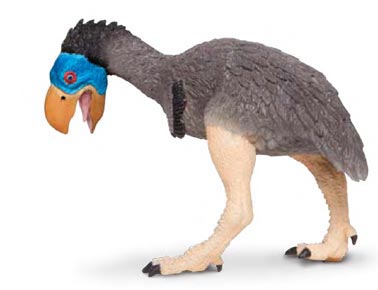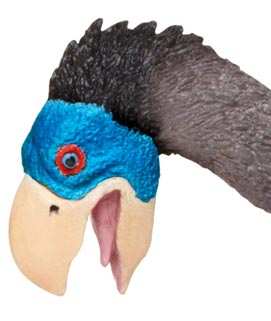Wild Safari Dinos Gastornis Replica Reviewed
New to the Wild Safari Dinosaurs and Prehistoric Life model series manufactured by Safari Ltd is a replica of Gastornis a giant, flightless bird that roamed the dense forests of Europe and North America during the Late Palaeocene and Eocene epochs before finally becoming extinct a little over forty million years ago.
The Gastornis Model from Safari Ltd
Picture credit: Everything Dinosaur
“Terror Bird”
Gastornis is often referred to as the original “Terror Bird” due to its reputation as being an apex predator. A reputation that was considerably enhanced when Gastornis featured in the first episode of the BBC television series “Walking with Beasts”. In this programme, Gastornis was depicted as one of the largest, terrestrial creatures on the planet, one that hunted and killed the primitive horse Propalaeotherium. Here was a prehistoric bird that ate horses, however, how the likes of Gastornis is classified with the rest of the birds is disputed. Most scientists assign the likes of Gastornis to the anseriformes – which means that Gastornis may be related to today’s ducks and geese.
Diatryma and Gastornis
The first fossils ascribed to the Gastornis genus were discovered in a suburb of Paris. Although far from complete and lacking any substantial skull material, a French geologist was given the task of formally naming and scientifically describing the fossil material. He did identify that the specimen represented a giant bird. The Gastornis genus was erected in 1855 and a number of species have now been recognised.
The American palaeontologist Edward Drinker Cope described a new genus of giant flightless bird based on fossils found in the western United States in 1876. The genus Diatryma was erected, but subsequent fossil finds have led scientists to conclude that Diatryma was so closely related that fossils from both America and Europe are often referred to as Gastornis, the senior synonym.
Gastornis Model Reviewed
This model from Safari Ltd does reflect the known fossil material well. The head is large, the model has a deep chest and a broad rump. The design team have been careful to pick out the small stubby wings, the rear of which have a line of short, black quills, which contrast nicely with the uniform coat of feathers found on the body.
The feet are a little over-sized, but this does not detract from the sculpt. The large feet help the model to stand and provide stability, this is a common feature of bipedal replicas. Each of the toes has a short, blunt claw, not a highly recurved talon. It seems that the model makers at Safari Ltd have taken into account trackway evidence assigned to Gastornis that indicate that this bird did not have big, sharp claws on its feet like a modern raptor.
The head is particularly impressive and the colour scheme which consists of a vivid blue face with a bright yellow beak compliments the muted tones on the body. The eyes have a red ring painted round them and the design team at Safari have been careful to depict the nostrils.
A Colourful Model
The broad beak reveals just a hint of a curve at the tip. Perhaps this is a male Gastornis in its breeding refinery setting out to impress any potential mates.
Despite Gastornis’s gruesome reputation with the BBC, scientists remain unsure as to the diet of this heavy-set creature. True, it was one of the largest land-living animals around during the Palaeogene period and there were very few large carnivores. It might have been a predator with tests on that broad beak and reinforced skull indicating that this bird and a bone crushing bite. However, the lack of any significant top-line curvature on the beak tip and the absence of talons has led some scientists to suggest that Gastornis may have been herbivorous with its beak making a useful nutcracker.
A Close up of the Gastornis Model
Picture credit: Everything Dinosaur
No fossils of feathers have been assigned to Gastornis, that gave the model makers at Safari Ltd a little problem. How to define the texture of the feathery coat covering the body. The team have opted to produce an effect similar to the shaggy, feathery coat seen on the Wild Safari Wildlife Ostrich model. Opting to do this rather than depict Gastornis with longer more strand-like feathers seen on flightless birds today such as the emu.
To view the range of Wild Safari Prehistoric World figures in stock on Everything Dinosaur’s user-friendly website: Wild Safari Prehistoric World Models and Figures.




Leave A Comment